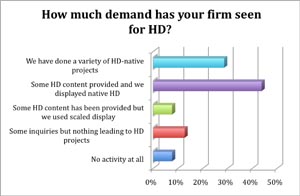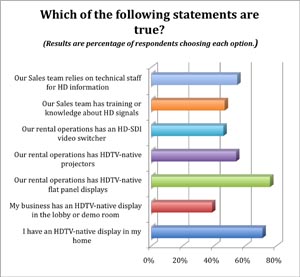Redefining Content Production As A Rental Service

- June marks a special time of the year for stagers. In some parts of North America, it's the start of the busy season, in others, the end. Fittingly it's also the month of InfoComm where so many of us stop to renew our interest in the cutting edge of technology and catch up with old friends. For a few days, we are all rental guys trying to find the next big thing. But technology has evolved in such a way that it is becoming hard to imagine a revolutionary new product. This year, I am trying a different tack: looking at the show as an end-user. Imagine having content -- imagery, graphics, information -- and not knowing how to share it. That's what many of your customers feel like. They look to you for solutions and often, all they see is a rental company.
- When considering new equipment for purchase, a rental-based business should calculate three things: Existing demand, future demand, and what demand can I create? Your gut tells you that you need to own low-density LED, digital video moving lights, HD projectors or widescreen scalers in order to sell a larger share of bigger shows or interesting projects. Your brain tells you that you won't have that kind of business until you own that kind of gear, but your accountant says you can't afford the risk. Then your gut reminds you that you didn't get into this business to rent flip charts. You can visualize your company doing certain kinds of projects, and those projects have specialized gear. Here's how to make the case to yourself, your boss, or your banker that you need to own that gear: Learn how to create the content first.
- I know what you're thinking: "I will buy the gear then learn how to use it."
- That's the way things used to be - back when you could afford to have the gear sit under-utilized while you figured out how to rent it. Today content (and content management) drives almost everything we do -- especially on the visual side of AV -- so before you buy a new content-dependent product, there has to be demand for that medium. One way to develop that demand is to learn how to produce for the medium by providing the content production to your customers. Let's face it; your customers, including producers, are in no position to figure this out. They will just hire someone who thinks they know what to do, have them produce it, and then blame you when it doesn't display correctly.
- Consider what today's meeting producer really is: a great salesperson who acts as general contractor. They are going to sub-hire most services, including content development. Why not broaden your role as their supplier? This will put you in a new position: teacher and partner. If you are the expert on maximizing the cool technology, then you will be the producer's partner when they do the sales pitch. This could reduce or eliminate the need for competitive bids for the AV support, because you are already the partner in the project.
- There are a few obstacles to overcome aside from the whole competing with your client thing. First of all, manufacturers need to do a better job of demonstrating content support for their own products and they need to pass this training on to their customers -- the AV stagers. Next, stagers need to invest in media content support: hire a video editor and/or graphics artist (they are often the same person) and invest in the latest computer hardware and programs. Finally, partner with your producer clients when they pitch for business. Then invite them to work with you when your end-client business needs creative support or complex production. Never forget, partnering is a two-way street.
- I bring this topic up (again) because one in five stagers I visit already have production capabilities. Only a handful is taking full advantage this advantage. It is not unusual to find editors, graphics artists, and designers in a staging company. It is rare to see their energies focused into a producer services product or united by a producer in their midst, but a few firms have done just that. In any case, I always ask whether the production model affects their relationship with producers? Every one of these companies have cited a growth in producer business and an appreciation for the extra support the stager can provide to their client. The real upside is the growth in direct corporate business these production support services afford the stager.
- Let me make one last point. The future of AV is software. We are not using the capacity and capabilities of the products we already have often because we don't know what to ask these things to do. More and more new products are black boxes with computer chips waiting for clever programmers to unleash their power. Someone has to tell the manufacturer about the possibilities and the need. The stager is the best-positioned segment in the delivery chain to do this. We sit between the manufacturer and the creative producers that drive the need for content creation and new methods for delivery. If as AV stagers, we choose to surrender the role of innovative technology integrator -- then independent production managers and equipment wholesalers will fill it. When you get to InfoComm and see something cool on a screen, don't ask about the display device. Ask the manufacturer how they created the content.
HDTV Are We There Yet?
By Tom Stimson, CTS
Most AV Stagers are at least having an HD discussion with their clients if not actually staging HD projects, but penetration is not universal yet. This months survey yielded some interesting results and even more fascinating comments. 75 percent of respondents say their firm has staged events in an HD format, but only 54 percent have HD native projectors. Only half indicate that their sales teams have any training in selling HD and nearly half of those still rely on technical staff for HD expertise. 20 percent of the respondents companies have not done any HD to date.

We are already there. Even when the display and switching is in 4X3 aspect, the CEO's personal laptop is almost always a 16X9 or 16X10 screen. When we set the external output to 4X3 to match the display the question always becomes -- 'Why do the slides not look like my desktop?' Remember too, the broadcast world considers 1024x768 HD.
- George Ray, LMG
While we have done a number of high definition projects, only half of the material has actually been HD. There have typically been one to two main presentations in HD, and then the rest of the material is SD and PowerPoint. On the few occasions that we've gone HD all throughout, cameras included, the image quality has been phenomenal. Unfortunately, most of our day-to-day work and corporate clientele will not change unless they have to. - Joe Guilderson, Corporate Audio Visual Services

Just as BetaCam took over from 3/4 U-matic, HD will become the requirement via evolution. It makes little sense to invest in standard def gear, since the entire industry is moving to HD at a rapid pace. This will cause HD equipment prices to fall and manufacturers will simply not make SD equipment much longer. You can invest early and be ahead of the trend or you can bring up the rear. - Larry Whitlow, Vice President Operations, Show Department Inc and Resolution Digital Studios
If the price for HD were the same as SD would a client pick it? Every time! If it were 20 percent more, or 30 percent more, is it worth it? Probably. It is only when costs are doubled that it becomes a difficult decision. This equation is changing. Rapidly! - Jack Dussault. Video Applications
Download the complete May 08 Survey including dozens more comments from respondents at: www.trstimson.com/surveys.
A daily selection of the top stories for AV integrators, resellers and consultants. Sign up below.
Each month The Stimson Group conducts a short survey of AV industry professionals about a variety of topics. To participate in or comment on those surveys, email: surveys@trstimson.com.
